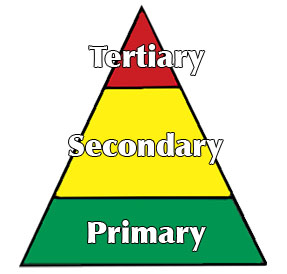Developing a School-Wide
Behavior Management System
Developing a School-Wide
Behavior Management System
The larger sizes of today's school, while bringing more curricular choice for students, present greater management problems. Societal changes and social ills have had an effect on student-to-student and student-to-teacher interactions. Educators are reporting an increase in the frequency and severity of misbehavior in our schools. What is a school to do?
In an attempt to create an orderly, respectful, and predictable school environment, many schools implement school-wide behavior management systems. Those systems, designed to promote positive behaviors and diminish inappropriate student actions, are developed through a multi-step and multi-faceted approach. Below you will find helpful information to assist your school in the development of it's program.
STEPS TO FOLLOW
While there is no simple formula for creating the perfect large-scale behavior management system, a number of important components have been identified by researchers and practitioners. Below, you will find those components and questions that will guide you in the construction of your school's program. The process will vary somewhat from setting to setting, resulting in a plan specific to each individual school.
The Planning And Preparation Stages
There are many ways to organize your efforts for plan development. Feel free to modify the procedures below to better match your school environment.
1. Form committees to start work on the plan
Lead group
-lead teachers/supervisors/department chairs
-special ed teacher of students with behavior disorders
-administrator(s)
-consultant(s)
-volunteer(s) from the community
Feedback/Reformulation group (active members who periodically join the lead group for meetings and readers who provide feedback to the written documents).
-experienced teachers
-new teachers
-para-professionals
-support staff (guidance counselors, social workers)
-parents
-committee representatives of various groups
-student representatives (From all groups: athletic, disabled, alienated, cultural)
-volunteers
2. Develop an all-encompassing statement of purpose.
Here is an example; "The school community, including students, parents, teachers, administration, and others, work together to create and maintain a safe and supportive environment that promotes teaching and learning."
3. List a set of valued and important beliefs/principles.
These philosophical guidelines should support the all-encompassing statement. We are educators, not prison guards. We teach, not coerce. For systematic behavior management programs to work, there must be a positive focus with empathetic and equitable treatment of all parties. This positive focus should reflect a deeply felt commitment to respecting the inherent dignity of all humans, and a desire to help them become all that they are capable of being. We must ask ourselves: What behaviors and types of social interactions do we wish to see?
-"All individuals in the school will treat all others with respect, concern,
caring, and fairness."
-"All individuals in the school will display good citizenship and acknowledge
responsibility for their behavior."
-"Students are expected to attend all classes, arrive on time, and actively
engage in tasks."
-"Teachers will present a meaningful curriculum in a captivating manner."
-"Faculty has the right and duty to model and teach the principles of respect
for others and responsibility for one's actions."
- "The faculty will establish and use behavioral consequences in an
educational manner, helping students to appreciate the purpose of rules,
the importance of making amends, and the taking of responsibility for
improving their behavior."
-"Students have the right to be treated with respect, to expect fair and
consistent treatment from faculty, and to be able to voice and have their
opinions tested in a respectful forum."
-"Students have the responsibility to be aware of and abide by school rules,
regulations, and procedures."
4. Create a list of clearly defined expectations for behavior.
Students are more likely to follow the rules when they are:
-Known to all
-Clearly stated
-Fairly and consistently enforced
-Viewed by all as being important to the common good
-Consistent with the principles listed in step #3
5. Develop a program that helps students to understand and display the behaviors that are desired.
A welcoming, positive, and valuing school climate works toward helping students understand and abide by it's system. This goal is accomplished via curricula and training for problem solving, self control, conflict resolution, positive and respectful interaction with others. "Character education" is important. It's not what we see the kids do. It's what they do when we're not watching.
-Proactive (for all students)
-Reactive/remedial (specialized intervention for violators)
6. Devise a sequence of consequences.
A system that is perceived as fair is developed, in part, by implementing a series of consequences that are clearly defined, reasonable, equitable, and directed toward helping students abide by the system.
-Initial Steps: Initial interventions help offending students "buy into" the system. The administrator or committee in charge of discipline might ask accused youngsters to suggest a fair administrative reaction to their offenses. They will work with the youngsters to devise a fair disciplinary response that addresses retribution for infractions while assuring that the youngsters learn from the experience. They will also decide what will occur if the student commits the offense again.
-Remedial Steps: Repeated or severe violations should result in prescribed punitive or restitutional consequences. Offers to assist the youngsters with behavioral change should continue to be offered.
7. Develop total staff commitment to the new approach.
Esprit de corp and a sense of common purpose is essential. Unless the vast majority of the school community are committed to supporting and implementing the system in a consistent and continuous fashion, it will fail. Those who feel imposed upon will sabotage the system consciously or unconsciously (although evidence of program success can bring many former nay-sayers into the fold). Individuals at all levels (e.g., students, parents, community leaders, cafeteria staff, bus drivers, teacher assistants/para-professionals, teachers, support staff, administrators) should be given the opportunity to contribute to the improvement of the program plan before they are directed to abide by the group decision.
-Offer all faculty a chance to engage in the development of the plan
-Seek out members who appear disengaged or oppositional
-Conduct staff development sessions to familiarize all parties with the
program
8. Engage in an awareness/training program. Students who do not understand or appreciate the system might oppose it. The school should develop appreciation via:
-Holding assemblies
-Distributing announcements to students and parents
-Publishing material on a web site
-Arranging meetings with student leaders (official and unofficial). Be
sure that all student groups are represented.

Start Up
1. Implement the system. Start the program at a logical time of year (e.g., first day of school year, just before or just after a vacation break). Have extra personnel available during the first week to ensure consistent implementation.
2. Brag about the system and it's successes (or repair and revise it to become something of which to be proud).
3. Provide regular refresher sessions to students and teachers.
4. Train new staff who arrive after implementation of the plan. Train them with a manual and mentor, and monitor/improve their performance in a supportive and positive manner.
5. Provide continued staff development that will help teachers become more:
-Student oriented/pleasant natured/positively focused
-Positive and supportive in their behavior management
-Dynamic in their instructional style
-Skilled in presenting a rich, authentic and meaningful instructional
program that actively engages students
![]() Questions That Must Be Answered In The Affirmative
Questions That Must Be Answered In The Affirmative![]()
1. Are staff and others kept aware of the progress of the developing plan?
-Newsletters placed in mailboxes
-Staff meetings
-Web site
2. Are staff and others provided with opportunities to provide feedback?
-Anonymous response forms/questionnaires
-Staff meetings
-Welcomed into committee discussions for various
components/segments
FINAL PRODUCTS
![]() Several documents will result from the planning process:
Several documents will result from the planning process:
1. A student handbook:
The student document is more simplistic in scope and language than the faculty handbook, explaining the program in a positive and supportive manner. It includes:
-The overall statement of belief and purpose
-An introduction explaining the process and purpose
-An explanation of the steps to be followed
2. A faculty handbook.
The faculty document is much more comprehensive than the student version. It includes:
-The overall statement of belief and purpose
-An introduction explaining the process and purpose
-An explanation of the processes to be followed
-Forms to be used in the system
-A list of suggested readings for positive behavior management
-A rank ordered listing of future staff development topics and speakers
3. Forms to be used in the program
-Referral of student by teacher
-Student history form to keep accurate records on students' behaviors
-Parent contact form (informing them of their children's behavior and
offering to meet with them)
-Administrative intervention report form and the plan to help youngster
change behavior
-Student conference form with signatures of all parties to the
agreement(s)
-Proposed follow-up plan to an incident and check-off form to keep track
of progress
-Progress report
Each Handbook Will Have:
1. A well designed cover
-colorful
-meaningful (e.g., picture of school, mascot, name, etc.)
-statement/motto (e.g., "The goal of discipline is self-discipline.")
2. A statement of purpose (examples)
"We believe the school community, including students, parents, teachers, administration, and the governing body, must work together to provide a safe supportive environment that promotes teaching and learning."
"We shall establish clear guidelines for academic and social behavior and use discipline in a positive, supportive, logical, and consistent manner."
3. An introduction and explanation of the process that was undertaken
(example) "The middle school is designed to be a caring community dedicated to the guidance and education of young adolescents. The principles of respect and responsibility are foundational beliefs that should motivate all interactions within our community. To that end our school community has been involved in the creation of a systematic school behavior management system the creates a welcoming climate that is physically and psychologically safe for all. Over the last ** months, we have actively engaged in...etc... From this process comes ** documents: ...etc...
4. A listing of the steps of the comprehensive plan and a flexibility statement.
5. Copies of forms
Expect resistance at first. Many students (and faculty) will resist change. Consistency and support help to solidify the changes. Over time, the rock in the stream wears down.
| Click here for an example of a plan drafted for use in a high school. IIt differs from other plans in that it revolves around a "Code of conduct" rather than the typical enforcement of rules. It would probably be applicable to other grade levels as well. |
| Click here for a review of New York City's "Power of Choice" schoolwide system (Used in programs for students with emotional and behavioral disorders) |
RESOURCES
The preferred model for devising school-wide management systems is "School-wide Positive Behavior Intervention Supports" (SWPBIS), often shortened to "Positive Behavior Supports" (PBS). The website for information and planning can be found at: www.PBIS.org

![]()
Hey pooch! WALK in the hallways!
| Fetch Dr. Mac's Home Page |
Author: Tom McIntyre at www.BehaviorAdvisor.com